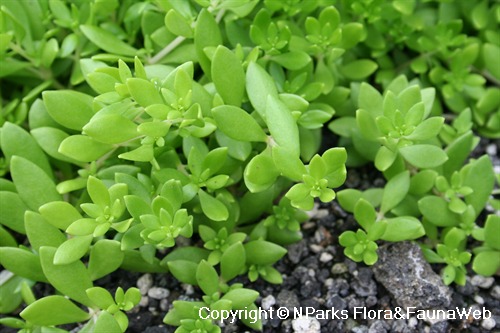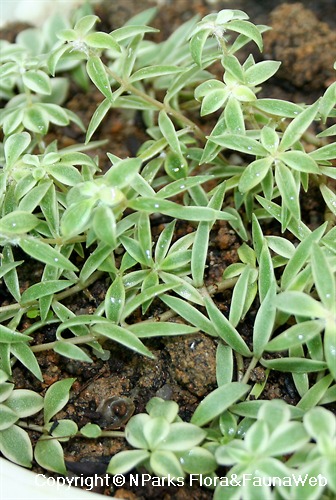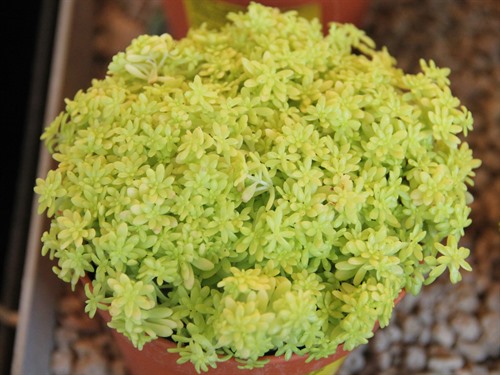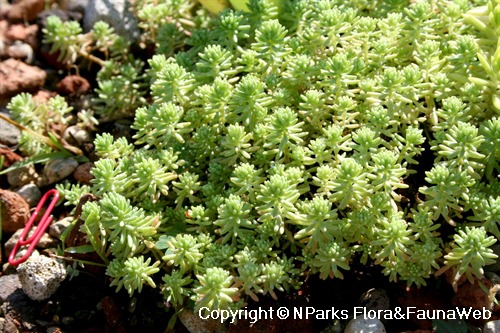
Back
Sedum sarmentosum Bunge
| Family Name: | Crassulaceae |
| Common Name: | Star Sedum, Stringy Stonecrop, Trailing Stonecrop, Yellow Moss, Gold Moss, Graveyard Moss, 垂盆草 |
Name
Classifications and Characteristics
| Plant Division | Angiosperms (Flowering Seed Plants) (Dicotyledon) |
|---|---|
| Plant Growth Form | Creeper, Herbaceous Plant |
| Lifespan (in Singapore) | Perennial |
| Mode of Nutrition | Autotrophic |
| Plant Shape | Shrubby |
| Maximum Height | 0.15 m |
| Maximum Plant Spread / Crown Width | 0.9 m |
Biogeography
| Native Distribution | China, Korea, Japan, Northern Thailand |
|---|---|
| Preferred Climate Zone | Sub-Tropical / Monsoonal, Temperate |
Description and Ethnobotany
| Growth Form | Herbaceous succulent, creeping or trailing shrub, forming dense mats of around 15cm height. |
|---|---|
| Foliage | Leaves light green, yellowish in very dry conditions, fleshy, obovate with pointed tip, arranged in whorls of 3 around stems. |
| Stems | Prostrate, creeping, extended by runners, rooting at nodes. |
| Flowers | Yellow, star-shaped, produced in clusters on stems with thinner needle-like leaves, not observed in Singapore. |
| Fruit | None, as flowers are sterile. |
| Cultivation | Prefers well-drained soils. Easily propagated by stem cuttings, leaf cuttings and divisions. Prune to prevent plant from running over other nearby plants. |
| Etymology | Genus epithet 'Sedum' derived from Latin verb for 'sit', referring to the way how some species attached themselves to rocks and walls. Species epithet 'sarmentosum' means 'having or bearing runners'. |
| Ethnobotanical Uses | Edible Plant Parts : Edible Leaves, Edible Stems Food (Herb or Spice) (Fruit or Vegetable) Others: Food: Young leaves and stems eaten raw or cooked as vegetable. Medicinal: Whole plant traditionally used to treat chronic viral hepatitis, and regulate gastric and renal processes in China and South Korea. Active ingredients commercially available as powder extracts. A known source of herbal phyto-estrogen. |
Landscaping Features
| Desirable Plant Features | Ornamental Foliage |
|---|---|
| Landscape Uses | Container Planting, Suitable for Rooftops, Suitable for Hanging Baskets, Vertical Greenery / Green Wall, Flowerbed / Border |
| Thematic Landscaping | Rockery / Desert Garden |
Fauna, Pollination and Dispersal
| Seed or Spore Dispersal | Abiotic (Explosive Dehiscence), Biotic (Fauna) |
|---|
Plant Care and Propagation
| Light Preference | Semi-Shade, Full Sun |
|---|---|
| Water Preference | Little Water |
| Plant Growth Rate | Fast |
| Rootzone Tolerance | Well-Drained Soils, Poor Infertile Soils, Shallow Media, Disease / Pest Resistant, Drought Tolerant |
| Maintenance Requirements | Moderate |
| Potential Problems | Spreads very quickly, may overtake surrounding plants. |
| Propagation Method | Seed, Stem Cutting, Leaf Cutting, Division |
Foliar
| Foliage Retention | Evergreen |
|---|---|
| Mature Foliage Colour(s) | Green |
| Mature Foliage Texture(s) | Smooth |
| Foliar Type | Simple / Unifoliate |
| Foliar Arrangement Along Stem | Spiral |
| Foliar Shape(s) | Non-Palm Foliage (Oblong) |
| Foliar Margin | Entire |
| Foliar Apex - Tip | Acute |
| Typical Foliar Area | Nanophyll ( 0.25cm2 - 2.25 cm2 ) |
| Leaf Area Index (LAI) for Green Plot Ratio | 4.5 (Shrub & Groundcover - Dicot) |
Non - Foliar and Storage
| Stem Type & Modification | Herbaceous |
|---|---|
| Root Type | Underground (Fibrous Root) |
| Specialised Storage Organ(s) | Aboveground |
Floral (Angiosperm)
| Flower & Plant Sexuality | Bisexual Flowers |
| Flower Colour(s) | Yellow / Golden |
|---|---|
| Flower Symmetry | Radial |
| Flower Size - Remarks | Small |
| Flowering Habit | Polycarpic |
| Flowering Period Remarks | Flowers in May-July in seasonal climates. Not observed to flower in Singapore. |
Fruit, Seed and Spore
| Fruit Classification | Simple Fruit |
|---|---|
| Fruit Type | Dehiscent Dry Fruit , Follicle |
Image Repository
Others
| Master ID | 1155 |
|---|---|
| Species ID | 2448 |
| Flora Disclaimer | The information in this website has been compiled from reliable sources, such as reference works on medicinal plants. It is not a substitute for medical advice or treatment and NParks does not purport to provide any medical advice. Readers should always consult his/her physician before using or consuming a plant for medicinal purposes. |




